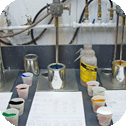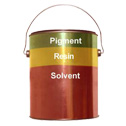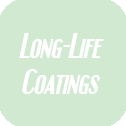About High-Performance Fluoropolymer Paint Coatings

High-Performance Fluoropolymer Paint Coatings
High-performance Kynar 500® PVDF resin-based coatings may be defined as a thin layer of plastic film containing resin, binder and pigments that is applied to the surface of an object to provide protection and a decorative organic coating.
The primary component of paint is referred to as the resin. The type of paint comes from the resin system - Polyvinylidene Fluoride (PVDF), Polyester, Acrylic, Polyurethane or Epoxy. It is not uncommon for a coating to contain several resins, which help the coating perform to specific requirements.
Paint Classifications: Paint coatings can be classified by function, curing system, volatile components, and resin system.
Function: Function can be described as filler, surfacer, size coat, primer, tie coat and clear coat.
Curing System: Different types of curing systems include air dry, air dry/force dry, bake/cure, catalyzed, and radiation.
Volatile Components: Solvents, waterborne (water based and water reducible) and 100% solids.
Resin System: Acrylic, Epoxy, Polyester, Polyurethane, Vinyl and PVDF (often referred to as Kynar or Kynar 500. Kynar 500® is not a finished paint, it is a trade name for PVDF (polyvinylidene fluoride) resin, as is Hylar 5000®. Kynar 500® is a registered trademark belonging to Arkema Inc.
The exact composition of a particular paint coating is often complex and proprietary. In general most paints contain resins, pigments, reducers and additives.
Resin: Resins are the compounds in the paint that form the film and hold the pigment in place. The resin system incorporated into the paint is the determining factor in the specific characteristics and performance properties. In the architectural industry, two primary resin systems are involved in refinishing of metals: fluoropolymer based (PVDF, Kynar) or "baked enamel" type, usually composed of acrylic or polyester resins.
Pigments: Pigments are the material added to the paint to give it color or to enhance certain physical properties of the coating. The selection of pigments is done on the basis of physical needs, durability, gloss, color fastness and chemical exposure. Pigments are both naturally occurring as well as synthetic.
Reducers: Reducers are used to serve different purposes. Using an active solvent will reduce the viscosity. Diluent solvent is used to extend a solution, but definitely weakens the power of the active solvent. Thinner solvent can extend a solution but does not impair the power of the active solvent.
Additives: Additives are usually paint type and specification specific. These can be added to enhance gloss, hardness and other characteristics.
Paint is in-house blended to meet the precise requirements of each unique project.
Linetec's color matching capabilities are unparalleled. Utilizing the latest technologies to analyze and formulate thousands of color variations ensures creation of the exact color specified.
When people describe paint systems, they are referring to the resin system incorporated in the paint.
The resin system determines the performance and properties of the paint. A typical gallon of paint is 10% pigment, 20% resin, and 70% solvent (reducers and additives).
Kynar 500® PVDF resin-based coatings provide protection against weathering, aging and pollution on buildings around the world.
The capability of Kynar 500 resins to deliver long-lasting durability is unmatched in the industry, and is still the architect's first choice.
The performance strengths and limitations of paint are summarized as follows:
Strengths of Paint
Limitations of Paint
PVDF Paint Overview
PAINT FAQ's
How is Paint Made
 Formulation of Paint
Formulation of Paint
 Paint Composition
Paint Composition
 High-Performance Kynar Coatings
High-Performance Kynar Coatings
Strengths & Limitations
Source: https://linetec.com
05 05 13 - Shop-Applied Coatings for Metal
09 96 56 - Epoxy Coatings
09 96 63 - Textured Plastic Coatings
